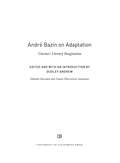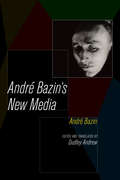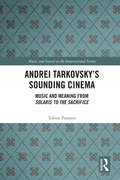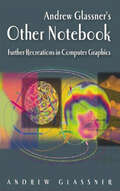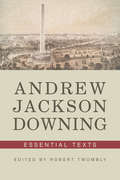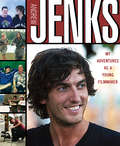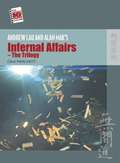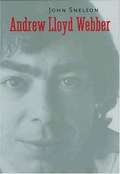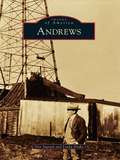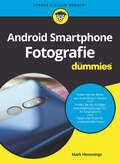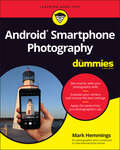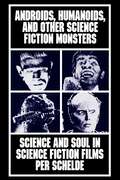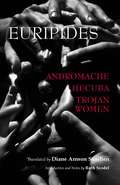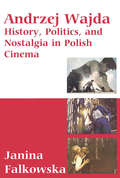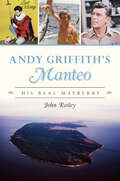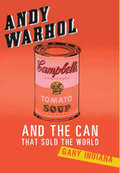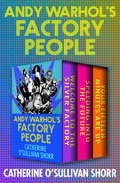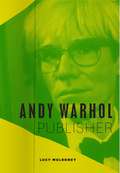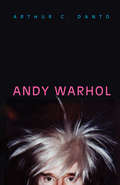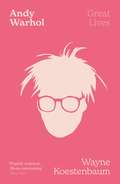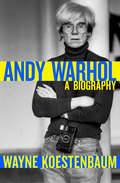- Table View
- List View
Andre Bazin on Adaptation: Cinema's Literary Imagination
by André BazinAdaptation was central to André Bazin’s lifelong query: What is cinema? Placing films alongside literature allowed him to identify the aesthetic and sociological distinctiveness of each medium. More importantly, it helped him wage his campaign for a modern conception of cinema, one that owed a great deal to developments in the novel. The critical genius of one of the greatest film and cultural critics of the twentieth century is on full display in this collection, in which readers are introduced to Bazin's foundational concepts of the relationship between film and literary adaptation. Expertly curated and with an introduction by celebrated film scholar Dudley Andrew, the book begins with a selection of essays that show Bazin’s film theory in action, followed by reviews of films adapted from renowned novels of the day (Conrad, Hemingway, Steinbeck, Colette, Sagan, Duras, and others) as well as classic novels of the nineteenth century (Bronte, Melville, Tolstoy, Balzac, Hugo, Zola, Stendhal, and more). As a bonus, two hundred and fifty years of French fiction are put into play as Bazin assesses adaptation after adaptation to determine what is at stake for culture, for literature, and especially for cinema. This volume will be an indispensable resource for anyone interested in literary adaptation, authorship, classical film theory, French film history, and André Bazin’s criticism.
Andre Bazin's New Media
by Dudley Andrew André BazinAndré Bazin's writings on cinema are among the most influential reflections on the medium ever written. Even so, his critical interests ranged widely and encompassed the "new media" of the 1950s, including television, 3D film, Cinerama, and CinemaScope. Fifty-seven of his reviews and essays addressing these new technologies--their artistic potential, social influence, and relationship to existing art forms--have been translated here for the first time in English with notes and an introduction by leading Bazin authority Dudley Andrew. These essays show Bazin's astute approach to a range of visual media and the relevance of his critical thought to our own era of new media. An exciting companion to the essential What Is Cinema? volumes, André Bazin's New Media is excellent for classroom use and vital for anyone interested in the history of media.
Andrei Tarkovsky Collected Screenplays (Faber And Faber Screenplays Ser.)
by William Powell Chia-Ning Chang Ian Christie Andrei TarkovskySince his death in 1986, Andrei Tarkovsky has become increasingly recognized as one of the great masters of world cinema. The book also contains an extended essay by film critic and historian Ian Christie, who places Tarkovsky's work in the context of Soviet film-making practice.
Andrei Tarkovsky's Sounding Cinema: Music and Meaning from Solaris to The Sacrifice (Music and Sound on the International Screen)
by Tobias PontaraAndrei Tarkovsky's Sounding Cinema adds a new dimension to our understanding and appreciation of the work of Russian director Andrei Tarkovsky (1932–1986) through an exploration of the presence of music and sound in his films. The first comprehensive study in English concentrating on the soundtrack in Tarkovsky’s cinema, this book reveals how Tarkovsky’s use of electronic music, electronically manipulated sound, traditional folk songs and fragments of canonized works of Western art music plays into the philosophical, existential and ethical themes recurring throughout his work. Exploring the multilayered relationship between music, sound, film image and narrative space, Pontara provides penetrating and innovative close readings of Solaris (1972), Mirror (1975), Stalker (1979), Nostalghia (1983) and The Sacrifice (1986) and in turn deeply enriches critical understanding of Tarkovsky’s films and their relation to the broader traditions of European art cinema. An excellent resource for scholars, researchers and students interested in European art cinema and the role of music in film, as well as for film aficionados interested in Tarkovsky’s work.
Andrew Glassner's Other Notebook: Further Recreations in Computer Graphics
by Andrew GlassnerHere, Andrew Glassner opens his notebook and invites readers into a wide range of stimulating explorations of art, nature and computer graphics. The text is accessible and informal, alongside images illustrating topics from Celtic knotwork and lightning to soap bubbles.
Andrew Henry's Meadow
by Doris BurnA classic reissued for a new generation Andrew Henry has two younger brothers, who are always together, and two older sisters, who are always together. But Andrew Henry is in the middle--and he's always with himself. He doesn't mind this very much, because he's an inventor. But when Andrew Henry's family doesn't appreciate him or his inventions, he decides it's time to run away. Many children in the neighborhood feel the same way and follow him to his meadow, where he builds each of his friends a unique house of their very own. But in town the families miss their children and do everything they can to find them. And the kids realize that it feels a little lonely out in the meadow without their parents. Just as relevant today as it was in 1967, this is a heart-warming story about children who want to feel special and appreciated for who they are. With a new jacket and expanded trim size, Andrew Henry is ready to enchant the next generation of kids.
Andrew Jackson Downing: Essential Texts
by Robert Twombly Andrew Jackson DowningA collection of essential writings by the father of landscape architecture and the urban park movement in the United States. Andrew Jackson Downing (1815-1852), a much-sought-after designer, influential writer, and editor of The Horticulturist, was an internationally known shaper of opinion. Robert Twombly has selected thirty-three essays on Architecture and Building, Landscape Gardening, Parks and Other Public Places, Village Beautification, Horticulture, and Agricultural Education, and provides an introduction to Downing's life and work and suggestions for further reading.
Andrew Jenks: My Adventures as a Young Filmmaker
by Andrew JenksMeet the filmmaker who is the voice of his generation!Behind the camera, Andrew Jenks has captured the attention of young adults everywhere with his innovative MTV documentary series, World of Jenks. When asked about his inspiration for the show, Jenks said, "I want to tell the stories of my generation. I want to be a filmmaker that is able to capture what my generation thinks, how they act, and what they ultimately stand for."Now fans of all ages will be able to discover everything they've ever wanted to know about Jenks, from growing up to becoming a renowned documentary filmmaker in this comprehensive photo-biography. How did he do it? By following his own rules for success-always be flexible, fake it till you make it, and never accept no.
Andrew Lau and Alan Mak's Infernal Affairs - The Trilogy
by Gina MarchettiInfernal Affairs has received journalistic, popular and corporate notice but little vigorous critical attention. In this book, Gina Marchetti explores the way this example of Hong Kong's cinematic eclecticism have crossed borders as a story, a commercial product and a work of art; and has had an undeniable impact on current Hong Kong cinema. Moreover she uses this film to highlight the way Hong Kong cinema continues to be inextricably intertwined with global film culture and the transnational movie market.
Andrew Lloyd Webber
by John SnelsonAndrew Lloyd Webber is the most famous--and most controversial--composer of musical theater alive today. Hundreds of millions of people have seen his musicals, which include Cats, The Phantom of the Opera, Starlight Express, Joseph and the Amazing Technicolor Dreamcoat, Jesus Christ Superstar, Evita, and Sunset Boulevard. Even more know his songs. Lloyd Webber's many awards include seven Tonys and three Grammys--but he has nonetheless been the subject of greater critical vitriol than any of his artistic peers. Why have both the man and his work provoked such extreme responses? Does he challenge his audiences, or merely recycle the comfortable and familiar? Over three decades, how has Lloyd Webber changed fundamentally what a musical can be? In this sustained examination of Lloyd Webber's creative career, the music scholar John Snelson explores the vast range of influences that have informed Lloyd Webber's work, from film, rock, and pop music to Lloyd Webber's own life story. This rigorous and sympathetic survey will be essential reading for anyone interested in Lloyd Webber's musicals and the world of modern musical theater that he has been so instrumental in shaping.
Andrews (Images of America)
by Linda Drake Don IngramAndrews County was named for Richard Andrews, the first casualty in Texas's fight for independence from Mexico in 1835 at the battle of Concepción. Before the creation of the county in 1876 by the Texas legislature, the area had been largely ignored by state officials and avoided by ranchers and settlers because of its remoteness, scarcity of water, and attacks by local Native Americans. That all changed in 1875 after an expedition by U.S. cavalry troops led by Col. William R. Shafter opened the region up to settlers. The town of Andrews became the county seat in 1910 after a close election race with nearby Shafter Lake. Ranching was the first economic driver in the county, but the discovery of oil in 1929 changed everything. The oil boom created jobs, brought in revenue, and attracted new residents. Today Andrews is experiencing growth thanks to renewed demand for oil, nuclear-related industries, first-class sporting venues, and other amenities that have rejuvenated the community.
Android Smartphone Fotografie für Dummies (Für Dummies)
by Mark HemmingsSie möchten hochwertige Bilder mit Ihrem Android-Smartphone aufnehmen? In diesem Buch erfahren Sie, wie Sie mit der Kamera, die Sie jeden Tag dabei haben, beeindruckende Fotos schießen. Mark Hemmings bringt Ihnen die Grundprinzipien der Fotografie bei und zeigt Ihnen, wie Sie dieses Wissen auf Außenaufnahmen, Actionfotos, Portraits und in Videos anwenden. Außerdem erfahren Sie alles über die Möglichkeiten der Bildbearbeitung und bekommen praktische Tipps, wie Sie Ihre Aufnahmen organisieren und Fotos online teilen.
Android Smartphone Photography For Dummies
by Mark HemmingsWait—you took that amazing picture? Taking a photo is as simple as point and click. Taking a good photo takes a bit more know-how, and Android Smartphone Photography For Dummies is your quick-and-easy guide. No matter what model of Android phone you have, this book teaches you to produce high-quality images using the powerhouse camera you carry in your pocket every day. You’ll learn the photography techniques pros use, like how to recognize beautiful outdoor lightning, how to capture moving subjects, and how to make stuff look good. Whatever kind of photos you want to take, this book will help you identify the gear and the apps you need for stunning results. With Dummies as your friendly instructor, you’ll be wowing your friends and family before you know it. Explore your phone’s camera, including little-known advanced features that will make a big difference in your images Figure out how to edit your pictures, correct lighting imbalances, apply neat filters, remove blemishes, and more Learn the basic principles of photography and apply your knowledge to outdoor photography, action shots, and still life Plus: capture video, organize your images, share photos online, choose a phone tripod, and protect your camera from the elements Dummies makes it easy for Android users of all skill levels to morph into masterful image-makers.
Androids, Humanoids, and Other Folklore Monsters: Science and Soul in Science Fiction Films
by Per ScheldeScience fiction films, from the original Frankenstein and The Fly to Blade Runner and The Terminator, traditionally have been filled with aliens, spaceships, androids, cyborgs, and all sorts of robotic creatures along with their various creators. The popular appeal of these characters is undeniable, but what is the meaning of this generation of creatures? What is the relationship of mad scientist to subject, of human to android, of creature to creator? Androids, Humanoids, and Other Folklore Monsters is a profound investigation of this popular cultural form. Starting his discussion with the possible source of these creatures, anthropologist and writer Per Schelde identifies the origin of these critters in the folklore of past generations. Continuing in the tradition of ancient folklore, contends Schelde, science fiction film is a fictional account of the ongoing battle between nature and culture. With the advance of science, the trolls, dwarves, pixies, nixies, and huldres that represented the unknown natural forces of the world were virtually killed off by ever-increasing knowledge and technology. The natural forces of the past that provided a threat to humans were replaced by the danger of unknown scientific experiments and disasters, as represented by their offspring: science fiction monsters. As the development of genetics, biomedical engineering, and artificial intelligence blur the lines between human and machine in the real world, thus invading the natural landscape with the products of man's techno-culture, the representation of this development poses interesting questions. As Per Schelde shows, it becomes increasingly difficult in science fiction film to define the humans from their creations, and thus increasingly difficult to identify the monster. Unlike science fiction literature, science fiction film has until now been largely neglected as a genre worthy of study and scholarship. Androids, Humanoids, and Other Folklore Monsters explores science fiction (sf) film as the modern incarnation of folklore, emblematic of the struggle between nature and culture—but with a new twist. Schelde explains how, as science conquered the forests and mountains of the wild, the mythic creatures of these realms—trolls, elves, and ogres—were relegated to cartoons and children's stories. Technology and outer space came to represent the modern wild, and this new unknown came alive in the popular imagination with the embodiments of our fears of that unknown: androids, cyborgs, genetics, and artificial intelligence gone awry. Implicit in all of these is a fear, and an indictment, of the power of science to invade our minds and bodies, replacing the individual soul with a mechanical, machine-made one. Focusing his analysis on sixty-five popular films, from Frankenstein and Metropolis to Invasion of the Body Snatchers, The Terminator, and Blade Runner, Per Schelde brings his command of traditional folklore to this serious but eminently readable look at SF movies, decoding their curious and often terrifying images as expressions of modern man's angst in the face of a rapidly advancing culture he cannot control. Anyone with an interest in popular culture, folklore, film studies, or science fiction will enjoy this original and comprehensive study.
Andromache, Hecuba, Trojan Women
by Euripides Ruth Scodel Diane Arnson SvarlienDiane Arnson Svarlien's translation of Euripides' Andromache, Hecuba, and Trojan Women exhibits the same scholarly and poetic standards that have won praise for her Alcestis, Medea, Hippolytus. Ruth Scodel's Introduction examines the cultural and political context in which Euripides wrote, and provides analysis of the themes, structure, and characters of the plays included. Her notes offer expert guidance to readers encountering these works for the first time.
Andrzej Wajda
by Janina FalkowskaThe work of Andrzej Wajda, one of the world's most important filmmakers, shows remarkable cohesion in spite of the wide ranging scope of his films, as this study of his complete output of feature films shows. Not only do his films address crucial historical, social and political issues; the complexity of his work is reinforced by the incorporation of the elements of major film and art movements. It is the reworking of these different elements by Wajda, as the author shows, which give his films their unique visual and aural qualities.
Andy Griffith's Manteo: His Real Mayberry
by John RaileyLearn about the real life of beloved actor Andy Griffith.The world loves Sheriff Andy Taylor. Yet the actor who played him was intensely private. Here, for the first time, is the real Andy Griffith, his career and life defined by the island that made him in the years soon after World War II. He achieved his artistic breakthrough while acting in The Lost Colony drama on Roanoke Island, then spent the rest of his life repaying the island for giving him that start. Here, in unique closeup, is Andy of Manteo, reveling in wild, watery and loving ways with his fellow islanders. Author and journalist John Railey paints an intimate portrait of Andy, based on interviews with many of those who knew him best on the sand where he lived and died.
Andy Warhol (Lives Of The Artists Ser.)
by Robert ShoreKing of Pop Art Andy Warhol is one of the greatest artists of all time. Rarely venturing into public without his camera and tape recorder, Warhol was a great observer and documentarist of the American social scene.Somewhere within the iconic images, carefully-made personae, star-studded milieu, million-dollar price tags and famous quotes lies the real Andy Warhol. But who was he? Andy Warhol,Robert Shore unfolds the multi-dimensional Warhol, dissecting his existence as undisputed art-world hotshot, recreating the amazing circle that surrounded him, and tracing his path to stardom back through his early career and his awkward and unusual youth. After Warhol, nothing would be the same – he changed art forever. Find out how with his remarkable story.‘Lives of the Artists’ is a new series of brief artists biographies from Laurence King Publishing. The series takes as its inspiration Giorgio Vasari's five-hundred-year-old masterwork, updating it with modern takes on the lives of key artists past and present. Focusing on the life of the artist rather than examining their work, each book also includes key images illustrating the artist’s life.
Andy Warhol (Lives of the Artists)
by Robert ShoreKing of Pop Art Andy Warhol is one of the greatest artists of all time. Rarely venturing into public without his camera and tape recorder, Warhol was a great observer and documentarist of the American social scene. Somewhere within the iconic images, carefully-made personae, star-studded milieu, million-dollar price tags and famous quotes lies the real Andy Warhol. But who was he? Andy Warhol,Robert Shore unfolds the multi-dimensional Warhol, dissecting his existence as undisputed art-world hotshot, recreating the amazing circle that surrounded him, and tracing his path to stardom back through his early career and his awkward and unusual youth. After Warhol, nothing would be the same – he changed art forever. Find out how with his remarkable story.‘Lives of the Artists’ is a new series of brief artists biographies from Laurence King Publishing. The series takes as its inspiration Giorgio Vasari's five-hundred-year-old masterwork, updating it with modern takes on the lives of key artists past and present. Focusing on the life of the artist rather than examining their work, each book also includes key images illustrating the artist’s life.
Andy Warhol and the Can That Sold the World
by Gary IndianaIn the summer of 1962, Andy Warhol unveiled 32 Soup Cans in his first solo exhibition at the Ferus Gallery in Los Angeles-and sent the art world reeling. The responses ran from incredulity to outrage; the poet Taylor Mead described the exhibition as "a brilliant slap in the face to America. ” The exhibition put Warhol on the map-and transformed American culture forever. Almost single-handedly, Warhol collapsed the centuries-old distinction between "high” and "low” culture, and created a new and radically modern aesthetic. InAndy Warhol and the Can that Sold the World, the dazzlingly versatile critic Gary Indiana tells the story of the genesis and impact of this iconic work of art. With energy, wit, and tremendous perspicacity, Indiana recovers the exhilaration and controversy of the Pop Art Revolution and the brilliant, tormented, and profoundly narcissistic figure at its vanguard.
Andy Warhol's Factory People: Welcome to the Silver Factory, Speeding into the Future, and Your Fifteen Minutes Are Up (Andy Warhol's Factory People #2)
by Catherine O'Sullivan ShorrBased on the television documentary: A three-part oral history of the Pop Art sensation&’s inner circle and their dazzling world of art, drugs, and drama. Featuring a new introduction by the author, special to this collection, this three-part companion volume to Emmy Award–winning Catherine O&’Sullivan Shorr&’s documentary Andy Warhol&’s Factory People is an unprecedented exposé of an exhilarating and tumultuous time in the 1960s New York City art world—told by the artists, actors, writers, musicians, and hangers-on who populated and defined the Factory. &“Different [in] its avowed bottom-up approach: Warhol as a function of his followers is the idea. This time . . . it&’s the interviews that tell the tale&” (Robert Lloyd, Los Angeles Times). Welcome to the Silver Factory: In 1962, frustrated with advertising work, Warhol sets up his legendary studio in an abandoned hat factory on Manhattan&’s 47th Street. The &“Silver Factory&” quickly becomes the hub of Warhol&’s creative endeavors—the space where he constantly works while an ever-changing cast of characters and muses passes through with their own contributions. Speeding into the Future: In a peak period from 1965 through 1966, Warhol creates the notion of the &“It Girl&” with ingenuous debutante Edie Sedgwick; discovers Lou Reed, the Velvet Underground, and Nico, the gorgeous chanteuse who becomes his next &“It Girl&”; and directs—with Paul Morrissey—his most commercially successful film, the art house classic, Chelsea Girls. Your Fifteen Minutes Are Up: By 1967, it seems that the Factory has outlived its fifteen minutes of fame. Superstars like Edie Sedgwick fall victim to drugs. Factory denizens have falling-outs with Warhol, as do the Velvet Underground, who are also caught up in disputes of their own. Into the chaos comes radical feminist Valerie Solanas, who shoots Warhol and seriously injures him. He survives—barely—but the artist, and his art, are forever changed.
Andy Warhol, Publisher
by Lucy MulroneyAlthough we know him best as a visual artist and filmmaker, Andy Warhol was also a publisher. Distributing his own books and magazines, as well as contributing to those of others, Warhol found publishing to be one of his greatest pleasures, largely because of its cooperative and social nature. Journeying from the 1950s, when Warhol was starting to make his way through the New York advertising world, through the height of his career in the 1960s, to the last years of his life in the 1980s, Andy Warhol, Publisher unearths fresh archival material that reveals Warhol’s publications as complex projects involving a tantalizing cast of collaborators, shifting technologies, and a wide array of fervent readers. Lucy Mulroney shows that whether Warhol was creating children’s books, his infamous “boy book” for gay readers, writing works for established houses like Grove Press and Random House, helping found Interview magazine, or compiling a compendium of photography that he worked on to his death, he readily used the elements of publishing to further and disseminate his art. Warhol not only highlighted the impressive variety in our printed culture but also demonstrated how publishing can cement an artistic legacy.
Andy Warhol: 21 Segi Changjojeok Injaeeui Rolmodel = [andy Warhol] (Icons of America #12)
by Arthur C. Danto&“Astutely traces the ripple effects of Warhol&’s blurring of the lines between commercial and fine art, and art and real life…masterful.&”—Booklist (starred review) Art critic, philosopher, and winner of a National Book Critics Circle Award Arthur Danto delivers a compact, masterful tour of Andy Warhol&’s personal, artistic, and philosophical transformations. Danto traces the evolution of the pop artist, including his early reception, relationships with artists such as Jasper Johns and Robert Rauschenberg, and the Factory phenomenon. He offers close readings of individual Warhol works, including their social context and philosophical dimensions, key differences with predecessors such as Marcel Duchamp, and parallels with successors like Jeff Koons. By drawing on subject matter understandable to the ordinary American, Warhol revolutionized the way we look at art. In this book, Danto brings to bear encyclopedic knowledge of Warhol&’s time and shows us Warhol as an endlessly multidimensional figure—artist, political activist, filmmaker, writer, philosopher—who retains permanent residence in our national imagination.
Andy Warhol: A Biography (LIVES #2)
by Wayne Koestenbaum'Properly analytical ... always entertaining' TIME OUT'Should tempt both those generally familiar with Andy Warhol and, even more, young people who have trouble imagining how popular art can challenge the status quo' L A TIMESPainter, filmmaker, photographer, philosopher, all-round celebrity, Andy Warhol is an outstanding cultural icon. He revolutionised art by bringing to it images from popular culture - such as the Campbell's soup can and Marilyn Monroe's face - while his studio, the Factory, where his free-spirited cast of 'superstars' mingled with the rich and famous, became the place of origin for every groundswell shaping American culture.In many ways he can be seen as the precursor to today's 'celebrity artists' such as Tracey Emin and Damian Hurst. But what of the man behind the white wig and dark glasses? Koestenbaum gives a fascinating, revealing and thought-provoking picture of pop art's greatest icon.
Andy Warhol: A Biography (Lives Ser.)
by Wayne KoestenbaumAn intimate depiction of the visionary who revolutionized the art world A man who created portraits of the rich and powerful, Andy Warhol was one of the most incendiary figures in American culture, a celebrity whose star shone as brightly as those of the Marilyns and Jackies whose likenesses brought him renown. Images of his silvery wig and glasses are as famous as his renderings of soup cans and Brillo boxes—controversial works that elevated commerce to high art. Warhol was an enigma: a partygoer who lived with his mother, an inarticulate man who was a great aphorist, an artist whose body of work sizzles with sexuality but who considered his own body to be a source of shame. In critic and poet Wayne Koestenbaum&’s dazzling look at Warhol&’s life, the author inspects the roots of Warhol&’s aesthetic vision, including the pain that informs his greatness, and reveals the hidden sublimity of Warhol&’s provocative films. By looking at many facets of the artist&’s oeuvre—films, paintings, books, &“Happenings&”—Koestenbaum delivers a thought-provoking picture of pop art&’s greatest icon.
